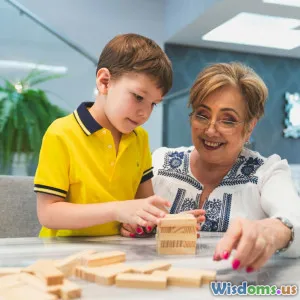
Is Technology Helping or Hurting Parent Child Relationships
10 min read Exploring how technology impacts parent-child relationships in our digital age—bridging gaps or creating divides? (0 Reviews)
Is Technology Helping or Hurting Parent-Child Relationships?
In our fast-paced, hyperconnected world, technology permeates nearly every aspect of daily life — including the delicate chemistry of parent-child relationships. Does the omnipresence of screens and devices enhance family bonds with new opportunities for connection and learning, or does it erode meaningful communication, replacing quality time with distractions? This question is deeply relevant as families navigate the digital age, balancing technological benefits with potential pitfalls.
In this comprehensive exploration, we'll untangle the complex effects of technology on parent-child dynamics, drawing on empirical research, real-life stories, and expert perspectives to shed light on whether technology is ultimately a help or a hindrance in fostering healthy relationships.
The Digital Reality for Modern Families
Technology as a Ubiquitous Presence
Smartphones, tablets, laptops, smart TVs, and gaming consoles have become almost like family members. According to a 2023 Pew Research Center report, 95% of teens have access to a smartphone, and 70% say they use the internet multiple times a day. Parents are often glued to screens as well, for work, social networking, or leisure.
This digital saturation means technology interfaces with family life constantly — whether during meals, car rides, or bedtime routines.
The Dual-Edged Sword
On one hand, technology increases opportunities for connection. Video calls allow parents who live apart from children due to work or separation to maintain frequent interactions. Educational apps can promote learning together. Shared digital interests like gaming or social media can become bonding experiences.
Conversely, overreliance on devices has been linked to decreased face-to-face interactions and parent and child feeling emotionally distant. The key inquiry is how families strike a balance.
Technology Helping Parent-Child Relationships
Facilitating Communication Across Distances
For families separated by geography, technology can be a lifeline. Platforms like FaceTime, WhatsApp, and Zoom enable real-time visual and verbal exchanges impossible in prior generations. Grandma in Florida can attend her grandson’s school play virtually; a military parent can hear a bedtime story from overseas.
Example: Lisa and her teenage son live apart due to work commitments. They schedule weekly video chats where they cook together virtually or watch movies "side by side," helping maintain a strong emotional connection.
Enabling Shared Experiences and Learning
Many parents use apps and online resources to guide children’s education, creating opportunities for joint activities. Coding games or science apps encourage adult involvement in skill-building.
For example, parents who may struggle to relate to millennials or Gen Z digitally can learn alongside their kids through joint gaming sessions or social media exploration — harnessing technology to bridge generational gaps.
Tools for Safety and Monitoring
Technology can also reassure parents by providing GPS tracking apps and communication tools that keep them connected and informed about their children’s whereabouts and wellbeing.
This functionality offers peace of mind without the need for intrusive face-to-face monitoring, thus granting children agency while fostering trust.
Encouraging Expression and Identity
Social media platforms offer children an outlet to express opinions, creativity, and find peer communities, with parents sometimes actively supporting or engaging in these spaces to understand their children’s inner worlds better.
Dr. Anita Raj, a family psychologist, notes, "When parents show genuine interest in their child’s digital life rather than dismissing it outright, it can open channels for dialogue and mutual respect."
Technology Hurting Parent-Child Relationships
The 'Digital Distraction' Phenomenon
An increasing body of research highlights the problem of "tech distraction," where parents’ or children’s constant device use interrupts quality interactions.
A 2022 study published in Computers in Human Behavior found that parents distracted by smartphones during mealtimes reported lower satisfaction with family communication. Meanwhile, children whose parents frequently checked devices felt less valued and more isolated.
Impaired Face-to-Face Communication Skills
Dependence on text messages, emojis, or social media can stunt development of critical interpersonal skills necessary for empathy, reading body language, and nuanced conversation.
If families opt for quick digital check-ins over in-person talks, young people may lack the social and emotional competencies that come from deep discussion.
Conflicts over Screen Time Limits
Setting and enforcing boundaries is often a source of tension between parents and children. Many parents struggle with balancing children’s technology use, causing arguments and power struggles.
A survey by Common Sense Media found that 56% of parents reported frequent conflicts with their kids about screens, and 32% admitted they felt guilty about enforcing limits due to work demands that necessitate their own screen use.
Cyberbullying and Online Risks
Parents less informed about digital environments may inadvertently leave children vulnerable to cyberbullying, sexting, or exposure to harmful content. Lack of open dialogue about online activities creates an environment rife with fear and mistrust.
The Impact of Social Media Comparisons
Children immersed in social media often engage in comparison culture, which can affect their self-esteem and family relationships. Parents who do not understand or support these experiences risk alienating their children.
Strategies to Leverage Technology Positively
Establish Intentional Tech Use
Creating "tech-free" zones or scheduled device-free times (such as mealtimes or family nights) can help families reclaim face-to-face time without feeling deprived.
Co-Engagement in Digital Activities
Parents taking active interest—playing video games with kids, consuming shows together, or exploring apps—significantly improves relationship quality. This not only teaches healthy digital habits but also expands shared interests.
Open Communication and Boundary Setting
Discussing technology’s pros and cons openly fosters trust. Parents who collaborate on screen time rules with children, explaining rationale rather than just issuing bans, report fewer conflicts.
Digital Literacy and Education for Parents
Instituting parent workshops and resources on digital risks and opportunities empowers adults to guide kids wisely, turning online environments into arenas for growth rather than conflict.
Prioritizing Emotional Connection
Ultimately, technology should serve as a tool to enrich underlying relationships, not replace them. Simple acts of listening, validating feelings, and spending quality undistracted moments remain paramount.
Conclusion: A Complex Relationship That Requires Balance
Is technology helping or hurting parent-child relationships? The answer is both. Technology is a double-edged sword in family dynamics — capable of both bridging gaps and building barriers.
The nuance lies in how families choose to integrate digital tools. When embraced thoughtfully—with boundaries, co-use, and open communication—technology enhances connection, learning, and safety. When left unmanaged or ignored, devices can isolate, distract, and suppress emotional bonds.
As technology inevitably evolves, so too must the strategies to make it an ally rather than adversary in parenting. Embracing mindful, informed approaches promises that the parent-child relationship not only survives but thrives, blending the best of human intimacy with the digital age.
References:
- Pew Research Center (2023): Teen smartphone ownership and internet use.
- Common Sense Media (2021): Parent-child screen time conflicts survey.
- Computers in Human Behavior (2022): Effects of parental smartphone use on family communication.
- Raj, Anita. "Navigating Digital Parent-Child Relations," Family Dynamics Journal, 2023.
By staying conscious of technology's profound influences, parents and children can write a new narrative where screens connect hearts rather than divide them.
Rate the Post
User Reviews
Popular Posts





















